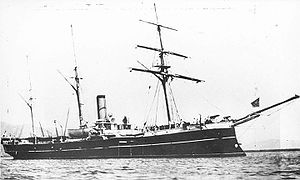Chernomorets (1886)

|
|
|---|---|
|
|
|
| Builder: | Admiralty Shipyard, Nikolayev |
| Keel laying: | May 9, 1886 |
| Launch: | 17th August 1887 |
| Commissioning: | 1889 |
| Period of service: | 1889-1918 |
| Displacement: | 1280 t |
| Length: | 67.2 m |
| Width: | 12.2 m |
| Draft: | 3.7 m |
| Drive: | Sails, two horizontal composite steam engines, 4 flame tube boilers, 2 screws 1819 HP |
| Speed: | 13.0 kn |
| Range: | 2100 nm at 6 kn |
| Crew: | 180 after 1918: 137 |
| Armament: | Guns:
from 1887:
Torpedo tubes
|
Chernomorets ( Russian Черноморец ) was the name of a sea-going gunboat of the Imperial Russian Navy . Commissioned in 1889, it was involved in the First World War. Sunk in 1920 and raised again the following year, it was demolished in the 1920s. The Chernomorets belonged to a class of eight boats. The name of the boat corresponds to the Russian name for a resident of the Black Sea.
The boat was procured as part of the fleet armament program for the years 1882-1902. It was intended for service in the Russian Black Sea Fleet .
The Chernomorets was laid on May 9, 1886 in the Admiralty shipyard in Nikolajew . Like all boats intended for service in the Black Sea Fleet, it was built in a Russian shipyard, while the boats intended for service in the Baltic Sea and the Far East were built in foreign shipyards. The launch took place on August 17, 1887. The boat was not put into service until 1889 after it had been equipped. After its commissioning, the Chernomorets was mainly used for diplomatic tasks and provided station service in various ports in the Black and Mediterranean . For example, the Greek port of Pylos was visited in December 1889 and in April of the following year.
In 1890 the Chernomorets served as an expedition ship for the research trips of the Russian geologist Nikolai Ivanovich Andrussow in the Black Sea. This expedition made an important contribution to the study of hydrography, geology and the flora and fauna of the Black Sea. For example, the expedition was the first to detect hydrogen sulfide in the Black Sea. The Chernomorets left Nikolayev on June 14, 1890 for a research expedition and set up the first measuring station on June 16 near Cape Tarchankut ( мыс Тарханкут ). During the expedition, the Chernomorets covered more than 2500 nautical miles . 60 measuring stations were set up, 37 of them in deep water, 889 measurements of the sea temperature and 446 determinations of the density of the sea water were carried out. Furthermore, with the help of incandescent lamps lowered into the water, the visibility in the water was determined at night. The expedition contributed significantly to new knowledge about the Black Sea and changed the ideas of science profoundly.
In 1895 the boat was constantly used in the Mediterranean. The Chernomorets at that time was the only Russian warship that was staying in the area. The boat remained in the Black and Mediterranean until 1900, after which it was assigned to the training units of the Black Sea Fleet in 1901. In the same year, a major overhaul took place.
When the White Guards withdrew from Temryuk in 1920, the boat was sunk by them, but was lifted again a year later and assigned to the ship recovery service of the port of Sevastopol . The boat was later abandoned for metal extraction, but the exact time can no longer be traced.
Individual evidence
- ↑ С. Игнатьев: Удивительный морской водоем (S. Ignatiev: Amazing Sea Reservoir ) (Russian)
- ↑ PM Мельников: Крейсер I ранга "Рюрик" (1889–1904 гг.) (RM Melnikow: 1st class cruiser "Rurik" (1889–1904)) (Russian)
Web links
- Photos (Russian)
literature
- А. Тарас: Корабли Российского императорского флота 1892–1917 гг. Харвест, 2000 (A. Taras: The ships of the Imperial Russian Navy 1892–1917. Harvest 2000) ISBN 985-433-888-6 .